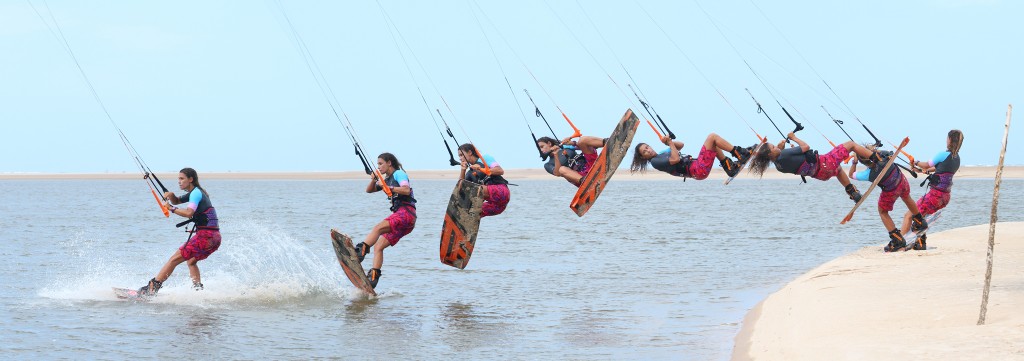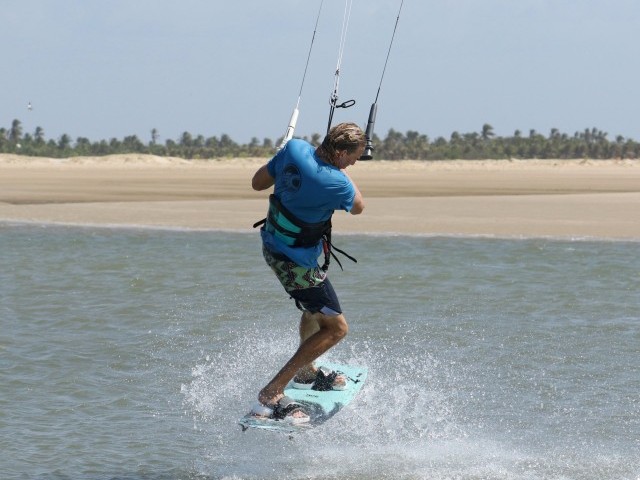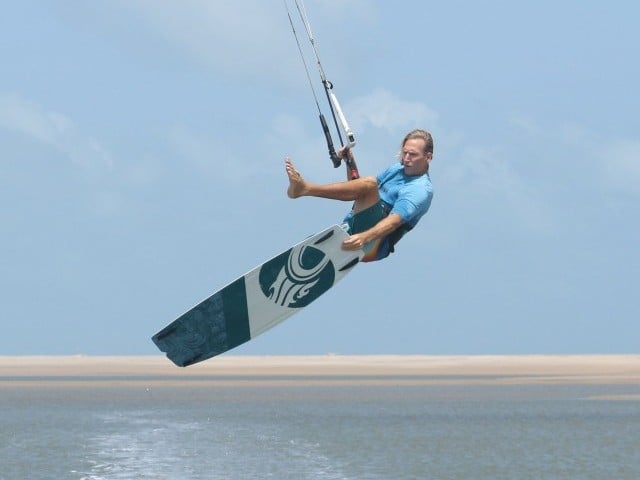
Beach Start Front Roll
Technique / Intermediate
Introduction
We spend a lot of time offering up different alternatives to a full plethora of moves, often ignoring a few areas. As such we relish the chance to give you a brassy alternative to jumping off the beach. Thus, we have the front loop or roll beach start. As the name suggests, we intend to marry two of your skills. As such it is a fine idea to have both a decent front rotation and a handy jumping beach start already in the bag. In case you’re not sure what we mean by a jumping beach start have a quick look at the sequence and/or video. Yup, it’s the type where you send the kite and jump off the beach, preferably in an offshore wind and definitely not in an onshore wind.
As is the norm, we’ll start by having a look at the individual parts that make this possible.
Set Up Pic A.
It’s all well and good having a go, but if you don’t have everything set up in the right place, to begin with, you’ll have little chance of success. For the sake of learning this, you should be looking for somewhere you can plant yourself on the beach with deep water directly downwind of you – it’s always good to have a soft landing! The first thing to sort is the position of your board. You want it facing across the wind. If you’re not 100% sure, it’s better to have the tail of the board pointing ever so slightly upwind, in preference to the nose pointing upwind. If you stand with the kite at 12 o’clock, the centre strut will show you which way the wind is blowing… Also, try and be on dry sand, as if it’s wet there’s a good chance that the board will stick. More so with the front rotation than with a standard beach jump as you won’t be using the board’s edge as much. Once you’re happy, get your feet in the straps or buckle up your boots. Trim your sweet spot out towards the middle of your centre line and then slowly move your kite back around the edge of the window until it’s around 1 o’clock or just under (11 if you’re jumping left to right). Once it’s there, you can pull the bar in slightly to keep your balance. As in the photo, you can see that Karine is close to the edge, on dry sand with her kite back at 1 o’clock and bar pulled in a tad for balance. You’re now locked and loaded and ready to rock and roll!
Send It Pic B.
Now, this is where things start to get exciting. You’re looking to get enough power to pull you up off the beach and get you away into the water, with enough time in the air to complete a cheeky front roll. Anyone who has tried a beach start will vouch that you’ll need to give it more beans than you think is sensible. Without getting to theoretical, the reason for this is that you’re standing still and as such your kite won’t be pulling as much as when you’re blasting along. Give the kite a hefty send forwards to generate enough power. It’s important that you send the kite from the sweet spot. The reason is much the same as for a jump. If you just yank on the front hand the kite will stall and rather than flying up and over; it’ll cut the top off the window and pull you downwind. So use two hands, push and pull, to get it moving quickly, and where you want. As the kite moves you need to resist the power, so drop your weight back and low against the pressure in your harness. This will help put tension on the lines and increase the lift you’ll get. It’s very tempting to let the bar out as you feel the kite pull, but giving away all that energy won’t do you any favours. You can see how Karine has given the bar a positive send with both hands, she’s dropped her weight into a sitting position and is pivoting the bar around the sweet spot.
Compress Pic C.
It’s not often that we’ll use compression when talking twin tip technique, but here is a genuine exception. You’ll be using your legs to help get airborne, and seeing as you are about to launch from terra firma, it seems only right to jump as we normally would with no kite. The idea being that we time our leg jump with the kite reaching 12, and therefore give it a helping hand in taking us up. As Karine feels the kite lifting, she drops her weight, even more, bending her legs, coiling up energy which she can then release. This is the time that the beach start gets different due to the front rotation. You can see that as Karine compresses she pulls the bar in, levelling it to slow the kites forward speed and for extra lift, but also she moves her weight forwards onto her front foot, leaning her head, shoulders and hips towards the nose of the board. This gets her ready to roll into her rotation.
The Launch Pic D.
As with so many moves, this moment of take-off will pretty much dictate whether you make it or you don’t. Your objective is to get yourself forwards and pop up off your front leg. This combined with the kite will get you rotating into your front loop. With the kite pulling her up Karine launches forwards, she extends her back leg, which rocks her onto the front of the board. Then she stamps off her front foot, which should be enough to initiate her rotation. Commitment is the key here, as you will feel the kite pulling you forwards, as opposed to up and back as per a sent front from the water, which could encourage you to bail. But have faith in your movements, and you’ll soon be up and off.
Just Like Old Times Pic E.
From here on in it should be business as usual. If you’re up and rotating all the same rules apply as for a sent front. You won’t have much time, so rotating quickly is a must. The best way to encourage a Tasmanian twist is to throw your head over your leading shoulder, bring your knees up close and look for your landing. Here Karine is leading with her head; she’s crunched up small, her bar is in and levelled - so she knows that she’ll make it around.
Touching Down Pic F.
Again the ending is just like that of a sent front. Your aim is to land down wind, tail first so that you can absorb the impact before carving back up onto your edge. Therefore, as Karine comes down, she dives the kite aggressively to pull her out of the rotation and give her a bit of extra downwind. She’s looking at where she thinks she’ll land and the board is coming around to a downwind position. Happy days!
Top Tips
It goes without saying that the prep for this is to hammer out a few front rolls and a few no rotation beach starts so that you can make sure that you’re rotating quick enough and get a feeling for how much power, and therefore send, you require for the beach launch.
Once you put them together, focus on going early enough that you’re getting lifted, and really concentrate on rolling onto the nose of the board. Imagine that you’re trying to press the nose down so that you can use the board’s flex to help you up.
And yet again if you know the water is deep enough to stack it, you’ll have far more confidence to go for it…
Now have a good look at the sequence and videos to get an idea of how the jump and roll combine in perfect harmony.
Common Problems
If you’re not getting off the beach, and therefore don’t feel that you have enough time or height to squeeze in the front loop. Three things will help here, assuming that there is enough wind and that your sweet spot isn’t trimmed right in for unhooking:)
First off, just like water starting when you were learning, if you need more power, start with the kite further back/ lower. This way you’ll use more window, but the power will still come as the kite reaches 12. If you just wang it from higher, the pull will come too late.
Secondly be positive with the bar. A decent push pull on the sweet spot. This will give you the feeling of power, which is what you want so don’t let the bar out.
And finally, if you pull the bar in too much as you’re sending, you’ll choke the kite, kill the power and eat sand.
If the board slips (and you’re not stalling), drop your weight onto your heels to edge a bit.
If you’re not getting the rotation. This is the tricky bit as you can just turn your head and hope. You have to get your weight forwards on the board so that you can start the rotation and get the energy going before you’ve left the sand. Concentrate on bending sideways at your waist, so that your front shoulder drops down towards the nose. Don’t throw yourself across the board.
If you’re getting around but drilling yourself into the water, chances are that you’re not levelling the bar on take-off, so the kite continues to dive fast, and therefore the lift disappears.
Keystones
- Board across the wind
- Kite 1, 11 or a tad lower
- Positive send on the sweet spot.
- Level bar and get weight over nose
- Compact and look for landing
This technique article was in Issue 62 of IKSURFMAG.
Related
By Christian and Karine
Christian and Karine have been working together as a coaching team, running improver to advanced kitesurfing clinics since 2003.






























